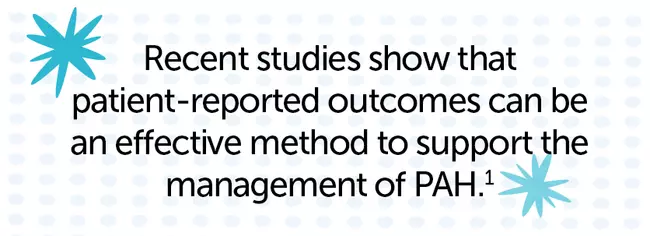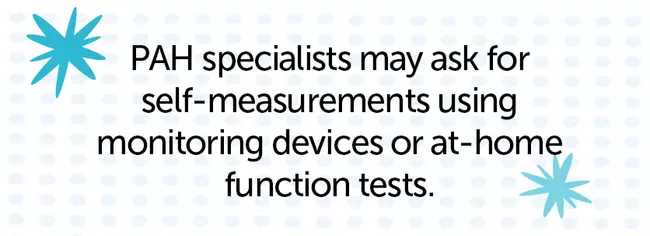
Powered By





 Continue with Facebook
Sign up with your email
Continue with Facebook
Sign up with your email
For people living with pulmonary arterial hypertension (PAH), frequent doctor’s appointments are vital for managing their condition. Risk assessment — estimation of the risk of death within one year — is key for monitoring disease progression and response to treatment. During the COVID-19 pandemic, accessing in-person health care has become more difficult. Fortunately, there is evidence that accurate self-reporting can make it possible for PAH specialists to effectively assess risk remotely.
Learn more about the role of risk assessment in managing PAH.
Doctors have honed the ability to perform accurate risk assessment via telemedicine, or online doctors’ visits, during the COVID-19 pandemic. Remote risk assessment relies on accurate self-reporting by people with PAH, especially when measuring functional capacity and mobility. Recent studies show that patient-reported outcomes can be an effective method to support the disease management of people living with PAH.

The Pulmonary Arterial Hypertension-Symptoms and Impact questionnaire (PAH-SYMPACT) is a particularly helpful tool for collecting accurate patient-reported outcomes for PAH. This measure covers nine “domains,” including respiratory and cardiovascular symptom domains, as well as the impact domains of physical activities, daily activities, social impact, cognition, and emotional impact. This questionnaire has been tested and verified in a variety of clinical trials.

Furthermore, common risk assessment tools for PAH, such as the U.S. Registry to Evaluate Early and Long-Term PAH Disease Management (REVEAL) 2.0 and the European Society of Cardiology/European Respiratory Society guidelines, do not require routine physical exams. The required measurements, such as heart rate and systolic blood pressure, can be monitored at home. This allows risk assessment to be performed more easily via telehealth appointments.
Read more about how risk is assessed in PAH.
Telemedicine appointments are typically on video chat platforms, allowing you and your doctor to see each other. These telecommunications can then be incorporated into your medical record. If you do not have a stable internet connection or do not feel comfortable with new technologies, you can also have a telemedicine visit over the phone. There are many ways a physician can monitor PAH during a telemedicine appointment.
Clinical history and an interview with your doctor are important for monitoring the progression of PAH and for adjusting PAH therapy. Be sure to report even minor changes in your condition. Even the most subtle worsening of symptoms could be significant to your doctor and affect your current treatment regimen.

Your doctor may also ask you to use home health-monitoring devices, such as smartwatches, scales, apps, and pulse oximeters, to take certain physical measurements. Some of the things a doctor may ask you about or monitor during a telehealth visit include:
Overall, telemedicine has helped lower the rate of missed appointments by making visits more convenient and reducing people’s anxiety about coming to a hospital during the coronavirus pandemic.
Telehealth visits are not new. Even before the COVID-19 pandemic, telehealth visits were scheduled between in-person visits to monitor a variety of conditions, including cardiovascular diseases. In a 2010 study, regular telehealth visits for people with heart failure reduced the rates of hospitalizations and death.
In a 2016 study from JAMA Internal Medicine, the use of wireless electronic devices that send daily information to a clinical nurse about a person’s vital signs — including blood pressure, heart rate, and weight — led to improved 180-day quality-of-life scores in participants with heart failure. Clinical trials such as these help to validate at-home monitoring visits as an alternative to standard, in-person clinic visits.
Maintaining a proper monitoring schedule is key for managing PAH. Telehealth appointments to monitor PAH symptoms and assess risk are an effective way to update your doctor on your condition and make sure your treatment plan is working for you.
On myPHteam, the social network for people with pulmonary hypertension and their loved ones, more than 47,000 members come together to ask questions, give advice, and share their stories with others who understand life with pulmonary hypertension.
Are you living with pulmonary hypertension? Share your experience in the comments below, or start a conversation by posting on your Activities page.
Get updates directly to your inbox.



 Continue with Facebook
Sign up with your email
Continue with Facebook
Sign up with your email
Become a member to get even more




A myPHteam Member
If you are not already allergic to cats then I don't believe the dust from cat liter will make matters any worse.Maybe someone else with cats can help on that though. Fluid retention will be a big… read more
We'd love to hear from you! Please share your name and email to post and read comments.
You'll also get the latest articles directly to your inbox.